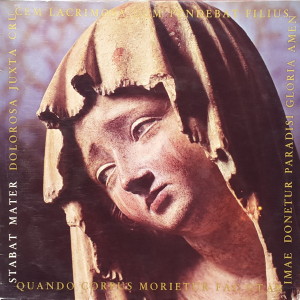 |
1 LP -
3501 - (p) 1970
|
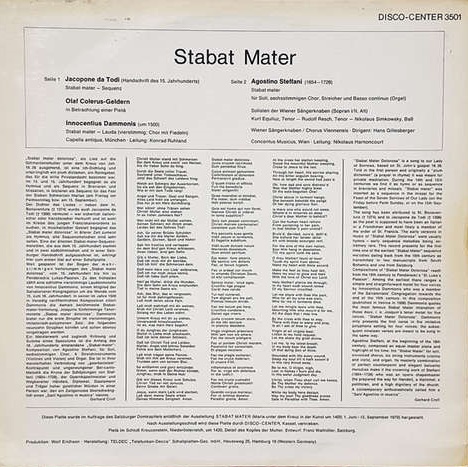 |
1 LP -
3501 - (p) 1970 (rectus)
|
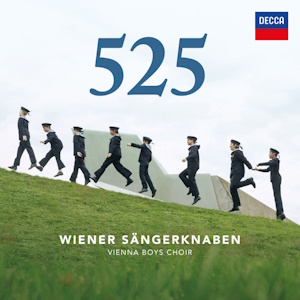 |
| 21 CD's
- 00289 484 6624 - (p) & (c) 2023 |
 |
Stabat
Mater
(Maria unter dem Kreuze in der
Kunst um 1400)
Austellung im Salzburger Dom
1. Juni bis 15. September 1970
(Katalog der ausstellung)
|
|
| STABAT MATER |
|
|
|
|
|
|
|
| Jacopone da
Todi (1236c.-1306) |
Stabat mater - Sequenz |
Handschrift des 15. Jahrhunderts) | (lecture)
|
|
5' 01" |
A1 |
Olaf
Colerus-Geldern (1928-2016)
|
In Betrachtung einer Pietà
| (lecture)
|
|
--' --" |
A2 |
| Innocentius Dammonis (um
1500) |
Stabat mater - Lauda
(vierstimme; Chor mit Fiedeln) |
|
2' 53" |
A3 |
| Agostino Steffani
(1654-1728) |
Stabat mater - für Soli,
sechsstimmigen Chor, Streicher und Basso
continuo (Orgel) |
|
28' 00" |
B1 |
|
- Stabat mater dolorosa
|
1' 45" |
|
|
|
- Cujus animam gemnentem |
2' 06" |
|
|
|
- Quis est homo qui non fleret
|
3' 07" |
|
|
|
- Pro peccatis suae gentis
|
1' 33" |
|
|
|
- Vidit suum dulcem natum
|
1' 07" |
|
|
|
- Eja mater fons amoris
|
1' 42" |
|
|
|
- Fac, ut ardeat cor meum
|
2' 45" |
|
|
|
- Tui nati vulnerati
|
1' 19" |
|
|
|
- Fac me vere tecum flere
|
2' 44" |
|
|
|
- Virgo virginum praeclara
|
1' 25" |
|
|
|
- Fac, ut portem Christi mortem
|
1' 14" |
|
|
|
- Fac me plagis vulnerari
|
1' 15" |
|
|
|
- Inflammatus et accensus
|
1' 58" |
|
|
|
- Quando corpus morietur
|
3' 55" |
|
|
|
|
|
|
Innocentius
Dammonis
|
Agostino
Steffani
|
|
|
|
|
| Capella
antiqua, München |
Solisten
der Wiener Sängerknaben: |
|
| Konrad
Ruhland, leitung |
-
Wolfgang Nowak, Soprano I
|
|
|
-
Peter Koch, Soprano II |
|
|
-
Wolfgang Kolecko, Alto |
|
|
Kurt
Equiluz, Tenor |
|
|
Rudolf
Resch, Tenor |
|
|
Nikolaus
Simkowsky, Bass
|
|
|
Wiener
Sängerknaben - Chorus
Viennensis / Hans
Gillesberger, Dirigent
|
|
|
Concentus
Musicus Wien
|
|
|
Nikolaus
Harnoncourt, Leitung |
|
|
Luogo e data
di registrazione
|
Salisburgo (Austria) - 1969
|
|
Registrazione
live / studio
|
| studio |
Producer / Engineer
|
Wolf Erichson
|
Prima Edizione
CD |
Decca | 00289 484 6624 | 21
CD's (CD 2, tracks 7-20) | (p) & (c)
2023 | Steffani only
|
Prima
Edizione LP 
|
Disco Center | 3501 | (1 LP) |
durata --' --" | (p) 1970
|
Note
|
Diese Platte wurde im
Auftrage des Salzburger Domkapitel
anläßlich der Ausstellung
STABAT MATER (Maria unter dem
Kreuz um 1400; 1. Juni - 15.
September 1970) hergestellt. Nach
Ausstellungsschluß wird diese
Platte durch DISCO-CENTER, Kassel,
vertrieben.
Questo disco è stato
appositamente commissionato dal
Capitolo del Duomo di Salisburgo
in occasione della mostra "STABAT
MATER (Maria unter dem Kreuz in der
Kunst um 1400)" tenutasi dal 1°
giugno al 15 settembre 1970 a
Salisburgo. Una volta terminata la
mostra questo disco prodotto in sole
300 copie e prodotto dalla Teldec, è
stato posto in vendita da
Disco-Center di Kassel.
|
|
|
Notes
|
"Stabat Mater Dolorosa"
is a song to our Lady of Sorrows, based
on St. John's gespel 19, 26. Told in the
first person and originally a "pium
dictamen" (a prayer in rhyme) it was
meant for private meditation. During the
14th and 15th centuries we find it as
hymn or as sequence in breviaries and
missals. "Stabat Mater" was inserted as
a sequence in the missal for the Feast
of the Seven Sorrows of Our Lady (on the
Friday before Palm Sunday, or on the
15th September).
The song has been attributed to St.
Bonaventura (+ 1274) and to Jacopone da
Todi (+ 1306) as the poet is supposed to
have been an Italian or a Frenchman and
most likely a member of the order of St.
Francis. The early versions in music of
"Stabat Mater Dolorosa" were usually
hymns - early sequence melodies being
extremely rare. This record presents for
the first time one of the earliest
"Stabat Mater" sequence melodies dating
back from the 15th century as
transmitted in two manuscripts from
South Bohemia and one from Salzburg.
Compositions of "Stabat Mater Dolorosa"
reach from the 15th century to
Penderecki's "St. Luke's Passion". Among
the earliest there ranges a simple and
straightforward motet for four voices by
Innocentius Dammonis who was a member of
the Salvatorians' Congregation towards
the end of the 15th century. In this
composition (published in Venice in
1508) Dammonis quotes the most famous
Stabat Mater intonation of those days,
i. e. Josquin's tenor motet for five
voices. "Stabat Mater Dolorosa".
Dammonis only presents the first verse
in the imitative polyphone setting for
four voices; the subsequent nineteen
verses are meant to be sung in the same
way.
Agostino Steffani, at the beginning of
the 18th century, composed an equal
master piece and highlight of his time:
his "Stabat Mater" for soli, sixvoiced
chorus, six string instruments (violins
and viols), and organ. Its masterly
combination of perfect counterpoint and
elegant belcanto melodies make it the
crowning work of Steffani (1654-1728)
who was an opera chapelmaster (he
prepared the way for Handel), a
diplomat, a politician, and a high
dignitary of the church. A contemporary
enthusiastically called him a
"Sant'Agostino in musica".
Gerhard Croll
|
|
|
Other Editions
|
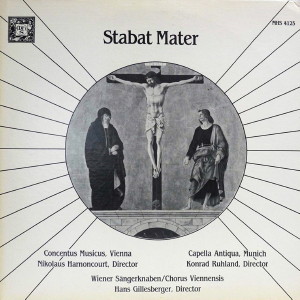 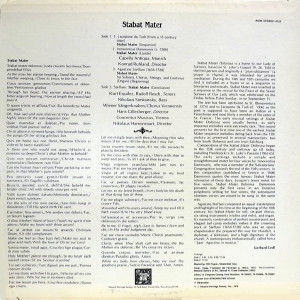 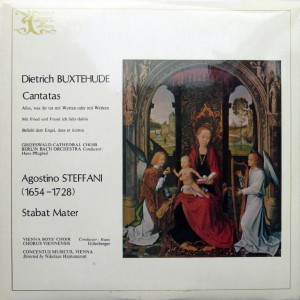 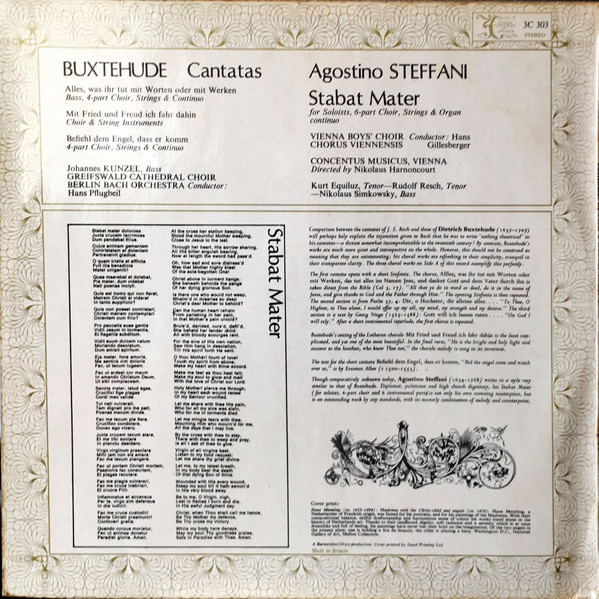 |
- Musical
Heritage Society, Inc. - MHS 4125 - 1 LP -
(p) & (c) 1979 - (without Olaf
Colerus-Geldern)
- Three Centuies of Musick - 3C 303 - 1 LP
- (p) 19?? - (with Buxtehude)
|
|
|
|
Nikolaus
Harnoncourt (1929-2016)
|

|

|
|